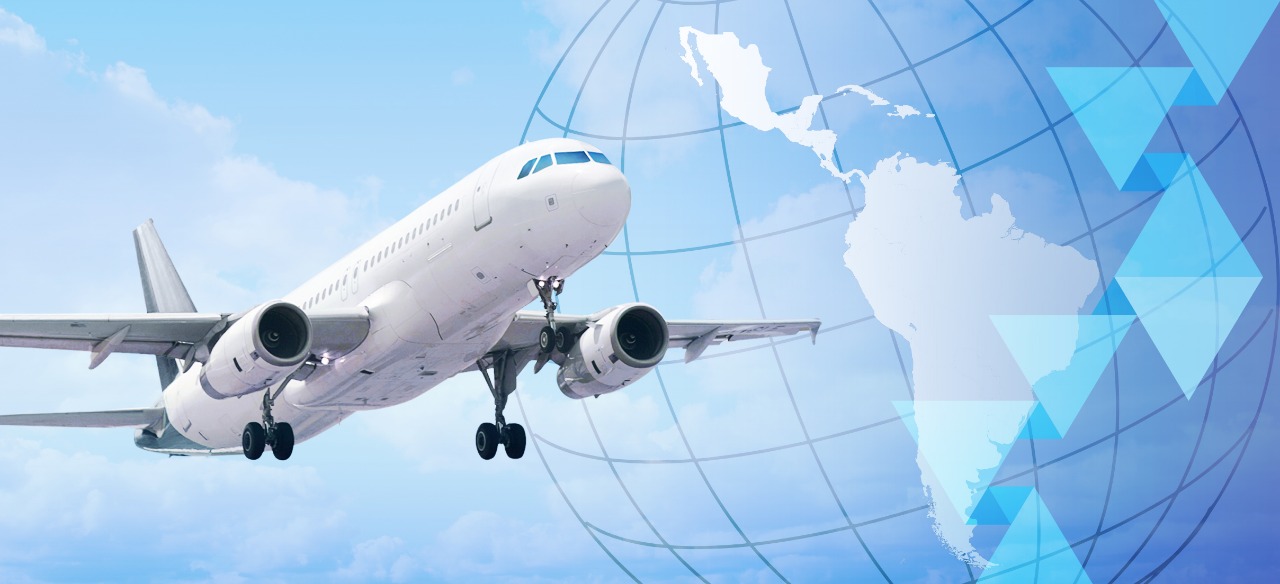
When the COVID-19 pandemic is under control and travel restrictions in the world are relaxed, the first sector of air transport that will begin with the recovery seems to be leisure as we have seen with all the increase of flights to beach destinations such as Los Cabos with 30% more flights published for Summer 2021 compared to 2019, and Latin America is indicated as the region that could have the best recovery rate in the world thanks to tourism from the United States and Canada.
Jared Harckham is Vice President and Managing Director of Aviation at ICF*. He is an expert in airline strategy, network and fleet planning, alliances and marketing with more than 30 years of experience in US and Mexican airlines. He has held planning positions at TWA and was senior vice president of business planning at Aeroméxico, where he led the efforts of strategy, planning, pricing, revenue management, government affairs, among other areas, as well as having participated in the founding and design of the Skyteam airline alliance.
In this exclusive interview with A21, Jared addresses the expectations of the recovery of tourism in the Latin American and Caribbean region, the challenges of the region in the context of the health emergency due to covid-19 and the consolidation of the industry once to overcome the pandemic, among other issues.
- Compared to 2019, where is tourism in the region today?
Policy changes and virus vaccination status cause confusion, and confusion lowers people's openness to travel. Now we know that it is safe to travel by plane, but there is the possibility of making a flight and changing a policy for the duration of your trip, or not knowing what type of medical services are in the country you visit if you catch the virus. The problem is the uncertainty, rather than the covid itself. We are seeing elements of hope, but until there is more definition, we will continue in limbo.
The news changes daily. I recently read that there are new variants of the covid in New York, and today the headlines said that if people take care of themselves, America can return to normal life by the summer. The news changes and a lot have to do with the status of tests and vaccinations and travel policy. Today the US continues with 10-day quarantines for almost every country in the world. Many people do not mind doing tests because they are used to it, but being locked up for ten days returning from abroad is not good.
- Which countries could be the most visited when the pandemic allows it?
I think that Mexico is in first place because it continues with a good level of national air traffic even in the pandemic, and I think that it will benefit from the travelers from the US and Canada, because we will see that people will begin to travel to nearby destinations that they already know. Mexico, the Caribbean, and Costa Rica are well known to people in those large markets, so these countries are going to make a good gain up front, while the more distant places are going to take longer to recover.
As for South America, we return to the idea that it is not dangerous to be on a plane, but we can run into the situation of arriving at a place where places of interest may be closed, such as restaurants, museums, and there is uncertainty about policies. If I live in Argentina and fly to Chile and in three days they change my return policy, it would complicate my trip. It goes on a case-by-case basis, and the countries that offer the greatest certainty in terms of their policies and health systems are going to have the advantage.
- ICAO indicates that Latin America could have the best recovery worldwide in percentage terms. How do you see the recovery for this year?
When I think of Latin America, the first thing that comes to my mind is Mexico and Central America, they are very large markets where there is a lot of traffic between these countries and the United States and Canada, it is the most important volume. In 2019, there were over 4.4 million passengers according to IATA PaxIS. People travel where they feel comfortable, where they have family, where they know the beaches. That may be one of the reasons, they are known destinations.
- What do you think about the use of health passports such as the IATA Travel Pass and the requirements to require certificates of vaccination against COVID-19?
Those are excellent ideas because nowadays having been vaccinated does not offer any advantage for traveling. If I leave my country on a trip, when I return I have to do tests, that's easy, but I still have to be at home for ten days. At the moment there is no advantage, I only have a card that certifies that I am vaccinated, but nobody respects it. Having this IATA tool is very useful because it establishes a global standard that airlines will use and that authorities will respect, which makes the procedure at airports more agile and will also encourage governments to recognize that they have to treat the vaccinated travelers in a different way than other people. In general terms, the Travel Pass, a digitized alternative, is excellent because with physical cards there is a greater possibility of fraud and it will take more time in the migration processes at airports if each paper is checked. Integrating it into a ticket as it is done with the US Global Entry will be more agile.
Regarding the possibility of damages due to the emergence of different digital passports, it will be standardized at some point. There may be different brands, but it has to be standardized via ICAO, IATA or some entity that establishes certain criteria, and in a certain way approves them once they meet the security requirements.
There may be several, but in any case, they must ensure that they are safe, reliable and accepted by governments.
- Three of the main airlines in Latin America are in Chapter 11, how is this going to affect the recovery of traffic in Latin America to the recovery of connectivity in the region?
In the end, the effects will be for the better. At the time of restructuring there is some uncertainty, but as in the case of Aeroméxico, since working in this airline years ago, it has never resolved its structural costs in labor contracts and has always been flying with high costs due to so many rules in contracts. At last, in this bankruptcy, they are solving this, which will lower the costs of the airline, making it more competitive, which will help it to be healthy and ready to grow and do what it has to do, like bringing in more planes. If the bankruptcy restructurings are done well, they will resurface better as it happened in the US 15 years ago when all operators came out with lower costs, more efficient contracts and grew, replaced their fleets, and reinvested to improve their operations. In the end they will be better, in my opinion, but that does not mean that there will not be strong competition.
In Mexico, low-cost companies such as Volaris and Viva Aerobus already dominate the majority of the domestic market and even the regional market, but there is a niche for both, it is not that Mexico does not require a full-service airline. There are many people and to provide connectivity with the world requires that airline profile, but also low cost can make the industry grow and allow many more people to fly.
- It seems that the low cost will have a boom in Latin America, with Volaris, Viva Aerobus, Viva Air Colombia, etc., everywhere it is growing a lot. Are we going to see a reduction in fares?
In the short term, fares will be lowered to attract passengers, but then we will return to normal fares. The low-cost ones offer good fares in normal times and nowadays they will offer cheaper, but I believe that they will raise their fares when they have the opportunity, since they have to try to recover the huge losses generated in 2020 as seen in previous disruptions such as 9/11
- Much has been said about the consolidation of the industry after the pandemic. We have at least seven new airlines that could start operations in Latin America, is this a contradiction or will we see a consolidation?
We have already seen the consolidation of full-service airlines such as LATAM and Avianca, and with the low-cost, in my experience, these airlines generally do not merge with each other, but what we can see is more than what we saw in Mexico with Interjet, almost disappearing. There may be winners and losers, rather than mergers. I do not want to say that I do not know of an acquisition or something similar, but for a low-cost merger with another similar company is not reasonable, it is better to continue growing. Not all will survive, but some will.
- Can we expect US airlines to boost their capacity in Latin America, mainly in Mexico and the Caribbean?
In a way, US airlines are already doing it. We did a study where we determined that Los Cabos already has 30% more capacity than in 2019. This is happening because of what I have said before, Los Cabos is a destination well known by people, travelers trust the health environment, and the airlines are putting in even more capacity than before. In the short and medium term, we will continue to see this type of capacity growth, but it may not stay that way forever. The airlines today have planes to fly to beaches in the Caribbean and in Mexico because they are not flying in their business markets and other routes, so when demand recovers and there are more flights in business markets, I think they must rebalance the capacity. Other cities in Mexico such as Leon or Aguascalientes, will not see a flood of new flights, because they are markets for visiting friends and family (VFR) or to a lesser extent business travelers, but the large volume will be in the market of vacations.
- What characteristics should a market have to have a better recovery?
First of all, a vacation spot, like Los Cabos.
Second, it must have good cleaning, sanitation and health programs and very good communication, as they have done in Los Cabos, the gold standard, in my opinion.
You must constantly communicate the steps that have been taken to make people feel safe and comfortable.
Finally, you must comply with what they advertise to the different markets.
Recovery will be more difficult for destinations other than beaches, such as cities, because people will be more cautious about going to a crowded place with less manageable crowds than on a beach, which is a small destination. I believe that having measures to operate safely during the pandemic is important, and almost everyone already has them, but it is essential to communicate them well and carry out campaigns that help travelers feel comfortable and cared for.
- What are your forecasts for the development of tourism in the Latin American and Caribbean regions?
If we view the pandemic event as an 18-month disruption to the industry's trajectory, I believe that at some point Latin America will regain its growth. It is an economically dynamic and emerging region, it has young populations who want to travel, and with the growth of low-cost airlines and low fares, a stimulation of traffic is allowed. The future is going to be good for the region if it is managed in the right way. Certain countries, including Argentina, are always playing with the industry, which is controlled by the government, has nationalized airlines. But in general terms, if you look at Chile, Peru or Mexico as examples, the airlines are going to be fine, the economies will continue to grow, and the population will continue to want to travel by plane.
There is also the issue of connectivity from Europe or Asia. I estimate that European countries will take a little longer to reconnect with the region because it is riskier for airlines and I think people will be a little afraid to travel that far immediately after the pandemic, but they will recover. Asia does not have as many flights, but we also expect to continue growing not so much because of tourism, but because of business traffic and cargo transport, while tourism will follow later. Economic connections have been established and connectivity will return to Asia because trade is not going away, and people will feel more comfortable traveling in a year and two.
- The pandemic has brought an increase in the digitization of travel and the adoption of new technologies. Can we expect these measures to be taken in our region?
As in the rest of the world, this situation has more to do with the age of the users. Younger people adjust in five minutes and older people take longer to get used to it, but it is the same all over the world. I have never read that in Latin America there is any difference. In terms of adopting health passports like the Travel Pass, it is up to governments and their agility, but expecting the public, airlines, and hotels to push for their use to be adopted and the government will have to.





Facebook comments